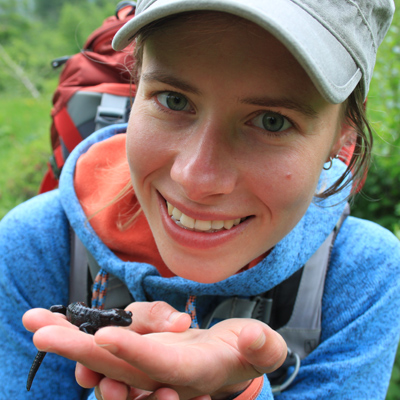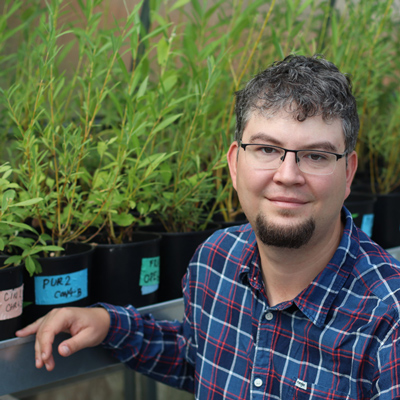


Tel Aviv University, Israel
Biosketch: Michal Gruntman is a senior lecturer at Tel Aviv University, Israel. Her work focuses on plant traits and the way they vary in response to the environment at ecological and evolutionary time scales. She studies plant responses to their biotic environment, including competition above and belowground or herbivory, as well as their abiotic environment such as water availability, soil salinity, and pollution. In her research, she uses model species, as well as native or invasive plants with varying evolutionary backgrounds to answer fundamental questions in plant ecology and explore the way plants are impacted by anthropogenic threats.
Title: Divided we stand: strategies and mechanisms of plant competition
Abstract: Competition plays a key role in plant ecology, and plants have evolved a wealth of physiological, anatomical and morphological responses to it, as well as the ability to perceive cues related to neighbor proximity both above and belowground. One of the best studied plant competition cues is the change in the composition of light reflected by neighboring vegetation to far-red-enriched light. In this talk, I will review different plastic responses exhibited by plants under such light competition cues, including (1) their aboveground shade avoidance and tolerance responses to neighbor height and density, (2) their ability to integrate aboveground competition cues into their belowground competition responses, and (3) their seed germination and dormancy strategies under competition.

Radboud University, Nijmegen, The Netherlands
Biosketch: Dina in ‘t Zandt is an Assistant Professor in the Department of Ecology at Radboud University in the Netherlands and a Marie Curie Fellow in Terrestrial Ecology at the Netherlands Institute of Ecology. Her research focuses on plant-soil microbiota interactions and their co-occurrence networks, testing how these interactions and networks are reshaped by global change, contribute to the resilience to plant communities during extreme climate events, and drive plant community patterns in time and space. Her research origins lie in mountain grasslands, but her more recent work has branched out to include other systems, including managed grasslands and forest ecosystems. Her research approach is grounded in ecological theory and field experiments, complemented by controlled experiments and data analytics to, ultimate, unravel the complex role of plant-soil microbiota interactions in ecosystem dynamics.
Title: Plant-soil microbiota interactions: drivers of plant species coexistence in time and space
Abstract: What drives plant species coexistence, and how can this knowledge be leveraged to preserve plant community diversity? Uncovering the mechanisms underlying coexistence of plant species is a long-standing challenge in ecology. Growing evidence suggests that interactions between plants and soil microbiota are critical actors in stabilising competitive differences among plant species. According to theory, negative interactions between plants and antagonistic soil microbiota serve as a stabilising mechanism by limiting the growth and competitive advantage of competitively strong plant species. However, testing this theory remains a significant challenge due to the sheer complexity and diversity of plant-soil microbiota interactions, as well as the long timescales over which plant species coexistence mechanisms operate. In this lecture, I will critically test whether empirical findings from short- and long-term experiments align with theoretical predictions, with a particular focus on mechanisms operating across temporal and spatial scales. Additionally, I will explore the plant-soil microbial mechanisms underlying these processes and ask: where do we go next?

Naturalis Biodiversity Center, Leiden, The Netherlands
Biosketch: Biodiversity on Earth is rapidly disappearing due to global change. My research ambition is to understand the processes responsible for the origin, diversification and adaptability of biodiversity, to be able to predict future declines and preserve ecosystems and their functions. In my research, I have shown that the evolutionary ‘match’ between plant functional traits and environments triggered explosive species radiations in certain groups, times and places, by fostering speciation or reducing extinction rates. I am exploring the generality of this across angiosperm lineages, and across large spatial (e.g., biodiversity hotspots) and temporal scales. Furthermore, to fully understand diversification, it is essential to integrate micro- and macroevolution. I do this by taking large, vertebrate-dispersed fruits (‘megafruits’) – dispersed by megafaunal animals – as a case study. Specifically, I evaluate the evolution of megafruit lineages, species and populations through geological time, especially since the extinction of their primary dispersers – the megafauna – in the Quaternary. By understanding the ultimate drivers of evolutionary diversification, I hope to contribute to improved conservation of biodiversity. In addition, I am passionate about communicating my research to a broader audience, for example, through the use of video and public talks.
Title: Diversification from lineages to populations
Abstract: Evolutionary radiations – i.e., lineages characterized by high net diversification rates (speciation rate – extinction rate) – are widespread across the Tree of Life. In fact, flowering plants (angiosperms) represent such a radiation, with extraordinary species richness and ecological dominance, especially compared to their sister lineage, the (acro-)gymnosperms. Nevertheless, the drivers and mechanisms underlying evolutionary radiations remain elusive. In this talk, I will integrate macroevolutionary and population genomics for palms (Arecaceae), a keystone tropical plant family with >2600 species. Using a trait-based comparative approach, I will show how palm speciation rates, historical demographic population histories, and population genetic differentiation are dependent on ecological interactions with fruit-eating and seed dispersing animals (frugivores). For example, palms with small fruits predominantly depend on small-bodied frugivorous mammals and birds for their seed dispersal, whereas palms with large fruits (‘megafruits’) depend on large-bodied frugivores (megafrugivores). The availability and movement abilities of these different frugivore guilds affect gene flow and genetic differentiation between palm populations, and ultimately reproductive isolation and speciation. I show that frequent long-distance dispersal across the large home ranges of megafrugivores has led to slower speciation rates in palms with larger fruit sizes. However, with the Late Quaternary extinction of megafauna, and the ongoing decline of large-bodied animals across tropical forests, megafruit palm populations may be suffering from dispersal limitation, range contractions, and potential risk of extinction. Overall, I argue that the integration of macroevolution, functional ecology, and population genomics is essential to scale up and down from lineages to populations, required to understand the evolution and diversification of angiosperms in past and contemporary ecosystems.

Department of Botany, University of South Bohemia, České Budějovice, Czech Republic
Biosketch: I am an early-career researcher with a strong interest in functional ecology. My work focuses on plants, primarily in temperate grasslands, exploring their responses to environmental factors and their effects on ecosystem functions. Recently, I have been concentrating on the role of plant diversity in ecosystem processes. After earning my Ph.D. in 2018 from the University of Montpellier, France, I held academic positions at the University of Lyon, France, and the University of South Bohemia, Czech Republic. Currently, I am a group leader at the department of Botany, Faculty of science, at the University of South Bohemia in České Budějovice. My research integrates experiments, theoretical frameworks, and advanced data analysis. I aim to bridge ecological theory with practical tools to enhance our understanding of "real-world" ecosystem functioning. In my talk, I will present recent advancements in understanding the drivers of the temporal stability of ecological communities. I will introduce a unified framework to disentangle the ecological processes that stabilize community functions, supported by examples from long-term datasets collected in diverse ecological contexts.
Title: The drivers of stability of ecological communities: from theory to data analysis
Abstract: Understanding the temporal stability of ecological communities is a long-standing challenge in ecology, with critical implications for biodiversity conservation and ecosystem functioning. Stability arises from multiple interacting mechanisms, including the stabilizing effects of dominant species, species asynchrony, and compensatory dynamics. While theoretical frameworks have provided key insights into these mechanisms, applying them in empirical analyses remains complex. In this talk, I will present an integrative perspective on the drivers of community stability, bridging ecological theory with a unified analytical framework. I will demonstrate how stability can be decomposed into its underlying components and highlight the flexibility of this approach for analyzing different ecological communities. Using empirical examples from plant communities, I will illustrate how this framework can be applied to assess the effects of climate, biodiversity loss, and fertilization on the ecological mechanisms underlying the temporal stability of biomass production in herbaceous ecosystems.

Institute of Entomology, Czech Academy of Science, České Budějovice, Czech Republic
Biosketch: I study insect-plant relationships, the evolution of plant defences, and chemical ecology, focusing on how insect-plant coevolution drives the remarkable chemical diversity in plants. My research spans macroevolutionary patterns of chemical diversity in response to natural enemies, intraspecific variation along ecological gradients, and temporal changes within individual plants to counter herbivores. I am particularly fascinated by the chemical defences of Salix and Ficus, key genera that support diverse herbivorous insects, as they can help us understand the feedback dynamics between the diversity of plant metabolites and insect communities.
Title: Potent, rich, or different: What governs plant chemical strategies and the astonishing diversity of their metabolites?
Abstract:
Plants produce astonishing diversity of specialized metabolites, with hundreds of thousands of metabolites described and many more remaining to be discovered. Recent advances in untargeted metabolomics allow us to measure thousands of metabolites from a single plant sample, classify them into chemical classes and pathways, and infer structural traits such as molecular weight or surface area. For the first time in history, these tools enable us to assess structural and functional phytochemical α- and β-diversity within and across plant species, offering new insights into plant chemical ecology. A key step towards understanding the genesis of the astonishing number of metabolites produced by plants is to reveal how various types of stress contribute to these individual dimensions of phytochemical diversity.
Our results from temperate and tropical elevational gradients show that abiotic stress supports a directional phylogenetic increase in metabolite concentration and selects for convergent chemical traits among plant species and communities growing in harsh environments. It contributes towards high concentration but low β-diversity in terms of both structural and functional variation of metabolites among highland plants. Conversely, under pressure from specialized enemies at low elevations, plants may be selected to switch to alternative defence strategies rather than invest in the richness or concentration of their current metabolites. This supports chemical niche partitioning and high chemical β-diversity among co-occurring species. We suggest that similar gradients in the relative importance of various types of stress can underlay global trends in the diversity of metabolites. We propose that linking metabolomics and community ecology concepts represents a powerful tool for predicting how habitat filtering and chemical niche partitioning shape the diversity of plant specialized metabolites.